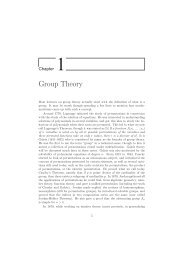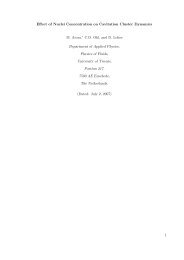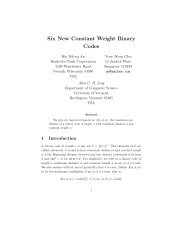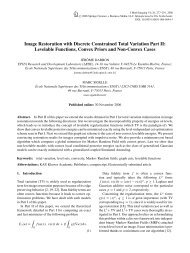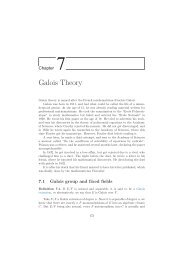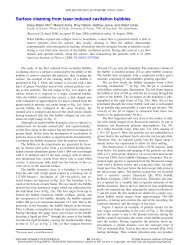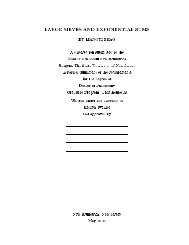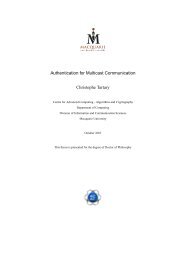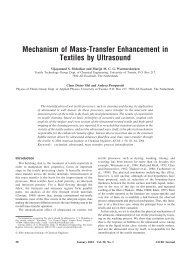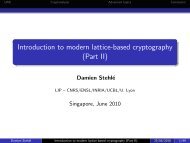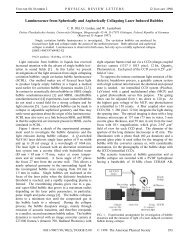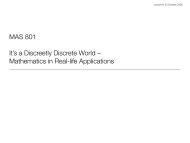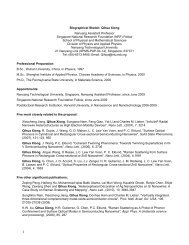EPCBC - A Block Cipher Suitable for Electronic Product Code ...
EPCBC - A Block Cipher Suitable for Electronic Product Code ...
EPCBC - A Block Cipher Suitable for Electronic Product Code ...
You also want an ePaper? Increase the reach of your titles
YUMPU automatically turns print PDFs into web optimized ePapers that Google loves.
<strong>EPCBC</strong> - A <strong>Block</strong> <strong>Cipher</strong> <strong>Suitable</strong> <strong>for</strong> <strong>Electronic</strong> <strong>Product</strong> <strong>Code</strong><br />
Encryption<br />
Huihui Yap 1,2 , Khoongming Khoo 1,2 , Axel Poschmann 2⋆ and Matt Henricksen 3<br />
1 DSO National Laboratories, 20 Science Park Drive, Singapore 118230<br />
2 Division of Mathematical Sciences, School of Physical and Mathematical Sciences<br />
Nanyang Technological University, Singapore<br />
3 Institute <strong>for</strong> Infocomm Research,<br />
A*STAR, Singapore<br />
{yhuihui,kkhoongm}@dso.org.sg, aposchmann@ntu.edu.sg, mhenricksen@i2r.a-star.edu.sg<br />
Abstract. In this paper, we present <strong>EPCBC</strong>, a lightweight cipher that has 96-bit key size and<br />
48-bit/96-bit block size. This is suitable <strong>for</strong> <strong>Electronic</strong> <strong>Product</strong> <strong>Code</strong> (EPC) encryption, which uses<br />
low-cost passive RFID-tags and exactly 96 bits as a unique identifier on the item level. <strong>EPCBC</strong> is<br />
based on a generalized PRESENT with block size 48 and 96 bits <strong>for</strong> the main cipher structure and<br />
customized key schedule design which provides strong protection against related-key differential<br />
attacks, a recent class of powerful attacks on AES. Related-key attacks are especially relevant when<br />
a block cipher is used as a hash function. In the course of proving the security of <strong>EPCBC</strong>, we could<br />
leverage on the extensive security analyses of PRESENT, but we also obtain new results on the<br />
differential and linear cryptanalysis bounds <strong>for</strong> the generalized PRESENT when the block size is<br />
less than 64 bits, and much tighter bounds otherwise. Further, we analyze the resistance of <strong>EPCBC</strong><br />
against integral cryptanalysis, statistical saturation attack, slide attack, algebraic attack and the<br />
latest higher-order differential cryptanalysis from FSE 2011 [11]. Our proposed cipher would be<br />
the most efficient at EPC encryption, since <strong>for</strong> other ciphers such as AES and PRESENT, it is<br />
necessary to encrypt 128-bit blocks (which results in a 33% overhead being incurred). The efficiency<br />
of our proposal there<strong>for</strong>e leads to huge market implications. Another contribution is an optimized<br />
implementation of PRESENT that is smaller and faster than previously published results.<br />
Keywords. <strong>Electronic</strong> <strong>Product</strong> <strong>Code</strong>, EPC, PRESENT block cipher, RFID encryption,<br />
lightweight cryptography.<br />
1 Introduction<br />
Theusageoftinycomputingdevicesisgainingpopularityintheconsumermarket,andtheyarebecoming<br />
an integral part of a ubiquitous/pervasive communications infrastructure. Thus it is crucial to employ<br />
well-designed lightweight cryptography <strong>for</strong> security purposes. A popular lightweight block cipher that<br />
fulfilsthisrequirementisthe64-bitblockcipherPRESENTwith80-bit/128-bitkey[10].PRESENTtakes<br />
only 1000−1570 GE to implement [10,44], is secure against differential/linear cryptanalysis (DC/LC)<br />
and is resistant against a slew of other block cipher attacks. As a consequence, PRESENT is currently<br />
understandardizationwithintheupcomingISO29192StandardonLightweightCryptography.In[9],the<br />
authors also generalized the PRESENT design concept to n-bit block size, in the context of designing<br />
hash functions. There was no description of a generic key schedule and no theoretical results on the<br />
security properties of the generalized PRESENT in [9]. In [33], Leander also defined small scale variants<br />
of PRESENT <strong>for</strong> the purpose of investigating the relationship between the running time of certain<br />
attacks and the number of rounds. He called these toy ciphers SmallPresent-[n] whose block sizes are<br />
⋆ The research was supported in part by the Singapore National Research Foundation under Research Grant<br />
NRF-CRP2-2007-03, and by NTU SUG.
4n-bit. Their key scheduling algorithms produce 4n-bit round keys from an 80-bit master key. In this<br />
paper, <strong>for</strong> ease of reference, we shall name the generalized PRESENT block cipher with block size n bits<br />
as “PR-n”.<br />
PRESENT only has 64-bit block size and this may not be suitable <strong>for</strong> applications which require<br />
lightweight encryption on a larger block size. One example is the upcoming <strong>Electronic</strong> <strong>Product</strong> <strong>Code</strong><br />
(EPC), which is thought to be a replacement <strong>for</strong> bar codes using low-cost passive RFID-tags, and in its<br />
smallest <strong>for</strong>m uses 96 bits as a unique identifier <strong>for</strong> any physical item [22]. A smaller block size of 64<br />
bits (e.g. PRESENT) requires two consecutive encryptions. On the other hand, the use of a larger block<br />
size of 128 bits (e.g. AES) results in a truncation to 96 bits which wastes internal state and ef<strong>for</strong>t. Our<br />
intention is thus to design a lightweight and efficient 96-bit block cipher <strong>for</strong> EPC encryption which has<br />
huge market implications, and at the same time improves previous analysis of PRESENT <strong>for</strong> increased<br />
confidence in security.<br />
We propose two variants of <strong>EPCBC</strong>: <strong>EPCBC</strong>(48,96) which has 48-bit block size and 96-bit key, and,<br />
<strong>EPCBC</strong>(96,96) which has 96-bit block size and 96-bit key. <strong>EPCBC</strong>(48,96) uses the PR-48 design <strong>for</strong><br />
the main cipher structure and <strong>for</strong> the key schedule, it uses an 8-round variant-Feistel structure with 4round<br />
PR-48 as the nonlinear function. <strong>EPCBC</strong>(96,96) uses the PR-96 design both <strong>for</strong> the main cipher<br />
structure and the key schedule.<br />
The security of <strong>EPCBC</strong>(96,96) against DC and LC relies on that of PR-96 cipher structure. The DC<br />
and LC bounds can easily be inferred from that of PRESENT [10], because the results of PRESENT<br />
applies to PR-n <strong>for</strong> any n ≥ 64. Our contribution <strong>for</strong> the analysis of <strong>EPCBC</strong>(96,96) is that we improve<br />
on the bounds of [10]. This allows us to deduce DC and LC bounds of <strong>EPCBC</strong>(96,96) which are tighter<br />
than the bounds obtained by applying the results of [10].<br />
However, in proving the security of <strong>EPCBC</strong>(48,96) against DC and LC, the DC and LC bounds<br />
cannot be inferred from that of PRESENT [10] because the block size n = 48 is less than 64. There<strong>for</strong>e,<br />
we prove new DC/LC bounds <strong>for</strong> PR-n when n < 64. Using these new bounds, we are able to prove the<br />
resistance of <strong>EPCBC</strong>(48,96) against DC and LC.<br />
A recent class of powerful attacks against block ciphers are related-key differential attacks [5,6,4,21]<br />
which can break well established standards such as AES-128 and KASUMI. Although the practicality of<br />
these attacks is arguable (due to the difficulty in obtaining related keys), resistance against related-key<br />
differential attack is especially relevant when these block ciphers are used as hash functions in Davies-<br />
Meyer mode (e.g. see [9] and Section 2 of this paper). This is an important issue, since many designer<br />
of RFID security protocols assume a lightweight hash function to be available on the tag [1,26,35]. Our<br />
customized key schedule design ensures many active S-boxes in the key schedule when there is a nonzero<br />
key differential. Consequently and in contrast to PRESENT, we are able to prove resistance against<br />
related-key differential attacks <strong>for</strong> both versions of <strong>EPCBC</strong>, which enables a secure usage of <strong>EPCBC</strong> in<br />
Davies-Meyer mode as a lightweight hash functions.<br />
Further, we show that <strong>EPCBC</strong> is resistant against currently best known integral cryptanalysis, statistical<br />
saturation attack, slide attack, algebraic attack and the latest higher-order differential cryptanalysis<br />
from FSE 2011 [11].<br />
On top of this, <strong>EPCBC</strong> per<strong>for</strong>ms well with respect to lightweight applications. In fact, <strong>EPCBC</strong>(48,96)<br />
has a slightly smaller area footprint than PRESENT-80, while at the same time offering a slightly<br />
higher speed, resulting in a 20% higher figure of merit (FOM). Our power estimates of 2.21 µW <strong>for</strong><br />
<strong>EPCBC</strong>(48,96) and 3.63 µW <strong>for</strong> <strong>EPCBC</strong>(96,96) (at 1.8V and 100 KHz) indicate how well <strong>EPCBC</strong> is<br />
suited <strong>for</strong> ultra-constrained applications, such as passive RFID tags. As another contribution, we present<br />
an optimized hardware implementation of PRESENT-80 that is both smaller and faster than previously<br />
published results.<br />
The remainder of this paper is organized as follows: in Section 2 we briefly recall the <strong>Electronic</strong><br />
product code be<strong>for</strong>e we propose two variants of EPBC in Section 3. Then we improve existing and prove<br />
new bounds <strong>for</strong> generalized PR-n in Section 4, which we will use <strong>for</strong> the security analysis of <strong>EPCBC</strong> in
Section 5. Hardware implementation results are presented in Section 6 and finally the paper is concluded<br />
in Section 7.<br />
2 The <strong>Electronic</strong> <strong>Product</strong> <strong>Code</strong> - EPC<br />
The <strong>Electronic</strong> <strong>Product</strong> code (EPC) is an industry standard by EPCglobal, designed to “facilitate<br />
business processes and applications that need to manipulate visibility data (i.e. data about observations<br />
of physical objects)” [22]. In other words, it is a unique identifier <strong>for</strong> any physical object. The standard<br />
also focuses on EPC class 1 Gen 2 RFID tag [23] as the carrier <strong>for</strong> the EPC and proposes a 96-bit unique<br />
identifier to be stored <strong>for</strong> low-cost applications. EPCglobal has specified seven application-dependent<br />
identification keys <strong>for</strong> EPC, such as Serialized Global Trade Item Number (SGTIN), Serialized Shipping<br />
Container <strong>Code</strong> (SSCC), or the Global Document Type Identifier (GDTI). These numbers consist at<br />
leastofacompanyprefixandauniqueserialnumbercommisionedbythecompany.Someapplicationalso<br />
comprise additional mandatory fields such as the document type in the case of GDTI. As a consequence,<br />
the length of the serial number varies between 36-bits and 62-bits (note that there are further restrictions<br />
on the choice of the serial number such as no leading zeros).<br />
An EPC class 1 Gen 2 RFID tag consists of four memory banks: one to store the kill and access<br />
passwords of 32-bits each, one <strong>for</strong> the EPC in<strong>for</strong>mation, one <strong>for</strong> the manufacturer in<strong>for</strong>mation about the<br />
tag itself, and one <strong>for</strong> user data. The tag manufacturer in<strong>for</strong>mation (TID) may contain a manufacturer<br />
ID, a code <strong>for</strong> the tag model, and a unique serial number, which can be used independently of the EPC.<br />
A globally unique identifier <strong>for</strong> any physical item certainly promises many benefits, such as optimized<br />
supply chains. On the other hand it could be a nightmare <strong>for</strong> privacy, especially since RFID tags could<br />
be read out without notion of its owner, and readers can be easily hidden and positioned at highly<br />
frequented locations. In this way unique movement patterns of single tags or a selection of tags can<br />
be created, which can be used to reveal the identity of their owner. For this reason a wide variety of<br />
protocols with the aim of securing privacy have been proposed. Out of these protocols, there are several<br />
which use lightweight cryptographic mechanisms with hash functions [46,42,47,26,20]. There are also<br />
some protocols which use pseudo-random number generators such as the privacy protocol proposed by<br />
Juels in [29]. In particular, Juels proposes a “minimalist” system in which every tag contains and rotates<br />
a short list of pseudonyms, emitting a different pseudonym on each reader query.<br />
A block cipher is a versatile building-block and, besides encrypting data, can also be used as a oneway<br />
function, a pseudo random number generator or a compression function. In a straight<strong>for</strong>ward way<br />
one would encrypt the whole 96-bit EPC, but one can also envision different scenarios where a user<br />
wants to either hide the serial number or the company’s identity <strong>for</strong> the sake of privacy. The <strong>for</strong>mer<br />
may be the case that a book is borrowed from a public library: it is fine <strong>for</strong> others to know that you<br />
borrow a book, but might not be when the book is on cancer treatment. The latter may be the case<br />
that a pharmaceutical product is bought: knowing the pharmaceutical company can reveal very sensitive<br />
in<strong>for</strong>mation, while a serial number might reveal no in<strong>for</strong>mation about the product.<br />
A wide variety of lightweight block ciphers optimized <strong>for</strong> ultra-constrained devices, such as passive<br />
RFID tags has been proposed over the last couple of years. Most notably are DESXL [34], KATAN [12],<br />
or PRESENT [10] among others. However, none of them has either key or block length that suits the<br />
uncommon 96 bits of an EPC and with the proposal of <strong>EPCBC</strong> in the next section we close this gap.<br />
3 A New <strong>Block</strong> <strong>Cipher</strong> <strong>Suitable</strong> <strong>for</strong> EPC Encryption: <strong>EPCBC</strong><br />
We propose two variants of <strong>EPCBC</strong>: <strong>EPCBC</strong>(48,96) which has 48-bit block size and 96-bit key, and,<br />
<strong>EPCBC</strong>(96,96) which has 96-bit block size and 96-bit key. (The testvectors are provided in Appendix<br />
A.2.)
3.1 <strong>EPCBC</strong>(48,96) - <strong>EPCBC</strong> with 48-bit block size and 96-bit key size<br />
The main cipher of <strong>EPCBC</strong>(48,96) iterates the PR-48 structure <strong>for</strong> 32 rounds, i.e. it uses the PRESENT<br />
description of Section 4.1 with n = 48 and r = 32. Due to n = 48, <strong>EPCBC</strong>(48,96) will be suited <strong>for</strong><br />
applications with the key being changed frequently. The choice of r = 32 ensures security of the cipher<br />
against differential and linear cryptanalysis as explained in Section 5.1.<br />
However, the key schedule of <strong>EPCBC</strong>(48,96) is different from that of PRESENT. The <strong>EPCBC</strong>(48,96)<br />
key schedule takes in the 96-bit secret key as a 96-bit keystate. The left half of the keystate is taken as<br />
the first subkey. Then a variant-Feistel structure is applied to the keystate <strong>for</strong> 8 rounds. Each nonlinear<br />
function F of the Feistel variant consists of 4 rounds of the PR-48 main cipher structure where a subkey<br />
is output after each round, giving 8 × 4 + 1 = 33 subkeys in total. The following is a description of<br />
the <strong>EPCBC</strong>(48,96) key schedule where 1Round denotes one round of PR-48 without subkey addition.<br />
Subkey[i] represents the subkey <strong>for</strong> round i of the main cipher.<br />
(LKeystate,RKeystate) = 96-bit key<br />
Subkey[0] ← LKeystate<br />
<strong>for</strong> i = 0 to 7 do<br />
temp ← LKeystate ⊕ RKeystate<br />
<strong>for</strong> j = 0 to 3 do<br />
RKeystate ← 1Round(RKeystate) ⊕ (4i+j)<br />
Subkey[4i+j +1] ← RKeystate<br />
end <strong>for</strong><br />
LKeystate ← RKeystate<br />
RKeystate ← temp<br />
end <strong>for</strong><br />
3.2 <strong>EPCBC</strong>(96,96) - <strong>EPCBC</strong> with 96-bit block size and 96-bit key size<br />
The main cipher of <strong>EPCBC</strong>(96,96) iterates the PR-96 structure <strong>for</strong> 32 rounds, i.e. it uses the PRESENT<br />
description of Section 4.1 with n = 96 and r = 32. The choice of r = 32 ensures security of the<br />
cipher against differential and linear cryptanalysis as explained in Section 5.1. The key schedule of<br />
<strong>EPCBC</strong>(96,96) is also different from the PRESENT key schedule. It takes in the 96-bit secret key as a<br />
96-bit keystate, outputs this keystate as the first subkey and applies the PR-96 main cipher structure 1<br />
to it <strong>for</strong> 32 rounds where a subkey is output after each round. Let 1Round denote one round of PR-96<br />
without subkey addition. Subkey[i] represents the subkey <strong>for</strong> round i of the main cipher.<br />
Keystate = 96-bit key<br />
Subkey[0] ← Keystate<br />
<strong>for</strong> i = 0 to 31 do<br />
Keystate ← 1Round(Keystate) ⊕ i<br />
Subkey[i+1] ← Keystate<br />
end <strong>for</strong><br />
4 Improved Differential and Linear Cryptanalyis of PR-n<br />
As we are using the structure of PRESENT <strong>for</strong> the main cipher of <strong>EPCBC</strong>, we did a security analysis of<br />
n-bit block size PRESENT (PR-n) against differential and linear cryptanalysis, and, we obtained new<br />
results. We first give a brief description of PR-n.<br />
1 Note that the hash function WHIRLPOOL[3] and the block cipher SMS4[19] also use an identical function <strong>for</strong><br />
both their main cipher and key schedule.
4.1 Brief Description of PR-n<br />
The detailed description of PRESENT can be found in [10]. The r-round encryption of the plaintext<br />
STATE can be written at a top-level as follows:<br />
<strong>for</strong> i = 1 to r do<br />
STATE ← STATE ⊕ eLayer(KEY, i)<br />
STATE ← sBoxLayer(STATE)<br />
STATE ← pLayer(STATE)<br />
KEY ← genLayer(KEY, i)<br />
end <strong>for</strong><br />
STATE ← STATE ⊕ eLayer(KEY, r +1)<br />
The eLayer describes how a subkey is combined with a cipher STATE, sBoxLayer (S-box layer) and<br />
pLayer (permutation layer) describe how the STATE evolves, and genLayer is used to describe the<br />
generation of the next subkey.<br />
According to [9], the building blocks sBoxLayer and pLayer can be generalized <strong>for</strong> n-bit block size<br />
PRESENT:<br />
1. sBoxLayer: This denotes use of the PRESENT 4-bit to 4-bit S-box S and is applied n<br />
4 times in<br />
parallel.<br />
2. pLayer: This is an extension of the PRESENT bit-permutation[10] and moves bit i of STATE to<br />
bit position P(i), where<br />
�<br />
i·<br />
P(i) =<br />
n<br />
4 (mod n−1), if i ∈ {0,1,··· ,n−2}<br />
n−1, if i = n−1.<br />
The sBoxLayer Denote the Fourier coefficient of a S-box S by<br />
S W b (a) = �<br />
(−1) 〈b,S(x)〉+〈a,x〉 .<br />
x∈F 4 2<br />
Then the properties of the 4-bit PRESENT S-boxes can be described as follows:<br />
S1. For any fixed non-zero input difference ∆I ∈ F 4 2 and any fixed non-zero output difference ∆O ∈ F 4 2,<br />
#{x ∈ F 4 2 | S(x)+S(x+∆I) = ∆O} ≤ 4.<br />
S2. For any fixed non-zero input difference ∆I ∈ F 4 2 and any fixed non-zero output difference ∆O ∈ F 4 2<br />
such that wt(∆I) = wt(∆O) = 1,<br />
{x ∈ F 4 2 | S(x)+S(x+∆I) = ∆O} = ∅.<br />
S3. For all non-zero a ∈ F4 2 and all non-zero b ∈ F4 2, it holds that |SW b (a)| ≤ 8.<br />
S4. For all non-zero a ∈ F4 2 and all non-zero b ∈ F4 2 such that wt(a) = wt(b) = 1, it holds that<br />
SW b (a) = ±4.<br />
As in the case of PRESENT [10], <strong>for</strong> PR-n where 16|n, we divide the n<br />
4 S-boxes into groups of four as<br />
follows:<br />
– Number the S-boxes from 0 to ( n<br />
4 −1) in a right-to-left manner.<br />
– Then Group j comprises S-boxes 4(j−1), 4(j−1)+1, 4(j−1)+2 and 4(j−1)+3 <strong>for</strong> j = 1,2,··· , n<br />
4 .
The pLayer For n ≥ 64, the (generalized) pLayer observe the following properties:<br />
P1. The input bits to an S-box come from 4 distinct S-boxes of the same group.<br />
P2. The input bits to a group of four S-boxes come from 16 different S-boxes.<br />
P3. The four output bits from a particular S-box enter four distinct S-boxes, each of which belongs to<br />
a distinct group of S-boxes in the subsequent round.<br />
P4. The output bits of S-boxes in distinct groups go to distinct S-boxes.<br />
For PR-48, observe that while P1 and P4 are still true, P2 and P3 do not hold. Instead of P3, PR-48<br />
(and in fact PR-n <strong>for</strong> all n, 16|n) obeys the following:<br />
P3 ′ . The four output bits from a particular S-box enter four distinct S-boxes.<br />
In the remaining of this paper, we only consider PR-n where 16|n.<br />
4.2 Improved Differential and Linear cryptanalysis<br />
Differential and linear cryptanalysis are among the most powerful techniques available to the cryptanalyst.<br />
In order to evaluate the resistance of a block cipher to differential and linear cryptanalysis, we<br />
provide a lower bound to the number of active S-boxes involved in a differential/linear characteristic. We<br />
first prove new bounds <strong>for</strong> the differential and linear resistance of PRESENT-n which are of particular<br />
interest with regards to n < 64.<br />
Theorem 1. Any 4-round differential characteristic of PR-n has a minimum of 6 active S-boxes.<br />
Proof. Suppose there are at most 5 active S-boxes <strong>for</strong> four consecutive rounds. The numbers of active<br />
S-boxes in the four consecutive rounds takes up one of the following patterns: 1-1-1-1, 2-1-1-1, 1-2-1-1,<br />
1-1-2-1, or 1-1-1-2. But the patterns 1-1-1 and and 1-2-1 are impossible by virtue of S2 and P3’. The<br />
result now follows. ⊓⊔<br />
Theorem 2. Let ǫ4 be the maximal bias of a linear approximation of 4 rounds of PR-n. Then ǫ4 ≤ 2 −7 .<br />
Proof. The proof is similar to that of [10, Theorem 2]. However note that when n < 64, the patterns<br />
(denoting the numbers of active S-boxes over four consecutive rounds) 1-2-1-1 and 1-1-2-1 are now<br />
allowed, in addition to the existing patterns of [10, Theorem 2]. But due to P3 ′ , we must have at least<br />
one active S-box with single-bit approximation over four rounds <strong>for</strong> all possible patterns. It follows that<br />
ǫ4 ≤ 2 4 ×(2 −3 )×(2 −2 ) 4 ≤ 2 −7 , as desired. ⊓⊔<br />
Remark 1. ThenewboundsinTheorems1and2areneededwhenanalyzingthesecurityof<strong>EPCBC</strong>(48,96)<br />
against DC and LC because the block size n = 48 is less than 64.<br />
In the remaining of this section, we state the improved and generalized results on the differential and<br />
linear probability bounds of [10]. As many technicalities and rigorous arguments are involved, we have<br />
included the <strong>for</strong>mal proofs of the theorems in Appendix A.1.<br />
Theorem 3. For n ≥ 64, the r-round differential characteristic of PR-n has a minimum of 2r active<br />
S-boxes <strong>for</strong> r ≥ 5.<br />
Remark 2. Note that if we have used the differential bound in [10, Theorem 1], we would only be able to<br />
deduce 10 (differential) active S-boxes every 5 rounds. For example, if there are 14 rounds, [10, Theorem<br />
1] would give 20 active S-boxes from 10 out of 14 rounds, the security margin from the remaining 4<br />
rounds is not captured. In contrast, Theorem 3 would give us 28 active S-boxes from 14 rounds.
Theorem 4. Let ǫr be the maximal bias of a linear approximation of r rounds of PR-n where n ≥ 64.<br />
Then ǫr ≤ 2 −2r+1 <strong>for</strong> r = 4,5,6,7,8 and 9.<br />
Remark 3. Note that [10, Theorem 2] only proves the LC bound <strong>for</strong> 4 rounds. If we consider linear<br />
cryptanalysis over e.g. 11 rounds, then applying [10, Theorem 2] would give us:<br />
ǫ11 ≤ 2×ǫ4 ×ǫ4 ≤ 2×2 −7 ×2 −7 = 2 −13 ,<br />
which only uses 8 out of 11 rounds, and the security margin from the remaining 3 rounds is not captured.<br />
If we apply Theorem 4, we obtain the tighter (better) bound:<br />
ǫ11 ≤ 2×ǫ5 ×ǫ6 ≤ 2×2 −9 ×2 −11 = 2 −19 .<br />
Theorem 4 enables us to use all 11 rounds in deriving the linear probability bound <strong>for</strong> PR-n, n ≥ 64.<br />
Remark 4. Note also that the linear probability bound <strong>for</strong> 8 rounds, which is given by ǫ8 ≤ 2 −15 , is<br />
better than applying the bound <strong>for</strong> 4 rounds twice, which is given by 2×(ǫ4) 2 ≤ 2 −13 .<br />
5 Security Analysis of <strong>EPCBC</strong><br />
We now present the results of a security analysis of <strong>EPCBC</strong>. 2<br />
5.1 Differential, Linear and Related-Key Differential Cryptanalysis<br />
Analysis of <strong>EPCBC</strong>(48,96) We assume minus-4 round attacks, so a distinguisher of <strong>EPCBC</strong>(48,96)<br />
is on 28 rounds. For protection against differential cryptanalysis, there are seven 4-round blocks in 28<br />
rounds. By Theorem 1, the differential characteristic probability is at most:<br />
∆28 ≤ [(2 −2 ) 6 ] 7 = 2 −84 < 2 −48 = 2 −blocksize .<br />
For protection against linear cryptanalysis, there are seven 4-round blocks in 28 rounds. By Theorem 2,<br />
the linear bias is at most:<br />
ǫ28 = (2 6 )×(ǫ4) 7 ≤ (2 6 )×(2 −7 ) 7 = 2 −43 < 2 −24 = 2 −blocksize/2 .<br />
For protection against related-key differential cryptanalysis, we consider the related key differential<br />
characteristic probability, given by p c|k×pk. p c|k is the differential characteristic probability of the main<br />
cipher conditioned on subkey differential and pk is the differential characteristic probability of the key<br />
schedule.<br />
We first bound pk which is the differential probability of the key schedule. A minus-4 round attack<br />
would involve 7 variant-Feistel rounds of the key schedule. By Theorem 1, every 4-round nonlinear<br />
functionF ofthevariant-Feistelstructureinthekeyschedulehasdifferentialprobabilityatmost(2 −2 ) 6 =<br />
2 −12 . It is easy to deduce that there are at least two active nonlinear functions F <strong>for</strong> every three rounds<br />
of the variant-Feistel structure. We consider all three possible cases: (∆LKeystate,0), (0,∆RKeystate)<br />
and (∆LKeystate,∆RKeystate) �= (0,0). Based on the structure of the variant-Feistel, it can then be<br />
shown directly that at least two of the three nonlinear functions have non-zero input differentials. Thus<br />
over 6 rounds of the key schedule, we have pk ≤ [(2 −12 ) 2 ] 2 = 2 −48 .<br />
By the key schedule design, we see that the differential of four consecutive subkeys are either all zero<br />
or all non-zero. In the case when the subkeys have non-zero differential, <strong>for</strong> a particular round of the<br />
main cipher, if the input differential is not cancelled by the key difference, then we have at least an active<br />
2 We leave the analysis of linear hull effect on <strong>EPCBC</strong> as future work.
S-box in the round. Otherwise, that round has no active S-box and zero output difference. Then the<br />
subsequent nonzero subkey difference when xored with this zero differential will cause an active S-box<br />
in the subsequent round. Hence, there are at least two active S-boxes every four rounds of the main<br />
cipher when the subkeys have non-zero differential. Hence over 28 rounds of the main cipher, there are<br />
at least 6 active S-boxes. This is because there are always at least three blocks of four consecutive rounds<br />
of the main cipher with non-zero key differentials. There<strong>for</strong>e p c|k ≤ (2 −2 ) 6 = 2 −12 and the related key<br />
differential probability satisfies p c|k×pk ≤ 2 −12 ×2 −48 = 2 −60 . Thus the attack complexity of related-key<br />
differential attack is at least 2 60 . Moreover, the adversary needs to obtain ciphertexts corresponding to<br />
2 48 related keys, which might be infeasible in practice.<br />
Analysis of <strong>EPCBC</strong>(96,96) We assume minus-4 round attacks, so a distinguisher of <strong>EPCBC</strong>(96,96)<br />
is on 28 rounds. For protection against differential cryptanalysis, we apply Theorem 3 on 28 rounds. The<br />
differential characteristic probability is at most:<br />
∆28 ≤ (2 −2 ) 28×2 = 2 −112 < 2 −96 = 2 −blocksize .<br />
For protection against linear cryptanalysis, there are three 9-round blocks in 27 out of 28 rounds. By<br />
Theorem 4, the linear bias is at most:<br />
ǫ27 ≤ (2 2 )×ǫ 3 9 ≤ (2 2 )×(2 −17 ) 3 = 2 −49 < 2 −48 = 2 −blocksize/2 .<br />
For protection against related-key differential attack, we need to bound both pk and p c|k as in the<br />
proof <strong>for</strong> <strong>EPCBC</strong>(48,96). By Theorem 3, pk ≤ 2 −96 . With some simple argument as be<strong>for</strong>e, we can prove<br />
that there are at least one active S-box every two rounds of the main cipher because the subkeys have<br />
non-zero differential. Thus p c|k ≤ (2 −2 ) 14 = 2 −28 and the related-key differential probability satisfies<br />
p c|k ×pk ≤ 2 −28 ×2 −96 = 2 −124 < 2 −96 . Thus related-key differential attack is infeasible.<br />
5.2 Other Attacks on <strong>EPCBC</strong><br />
Integral Attacks The integral attack [31] is a chosen plaintext attack originally applied to byte-based<br />
ciphers such as SQUARE and Rijndael. Lucks [37] ported it as the ‘saturation attack’ to Twofish, which<br />
is fundamentally a byte-based algorithm incorporating bit-oriented rotations. On this basis, the authors<br />
of PRESENT, which contains a bit-based permutation, discarded this attack almost out of hand. In<br />
2008, Z’aba et al. [48] developed the bit-based integral attack, which they applied to very reduced-round<br />
versions of Noekeon, Serpent and PRESENT.<br />
The attack categorizes each bit or byte across a structure of texts, as to whether or not it is balanced<br />
(the sum of its value in each text equals zero). At some point in the evolution of the text through the<br />
encryption, the balance property is lost. The attacker can guess parts of the subsequent round key, and<br />
partially decrypt this point. If the balance is not restored, the partial round key guess is incorrect.<br />
The details of the attack are driven by the structure of the linear permutation rather than of the<br />
S-boxes. The attack works best <strong>for</strong> ciphers in which the block size is less than the size of the secret key.<br />
It applies to seven of PRESENT’s 31 rounds, partly due to a weakness in its key schedule that allows<br />
61 bits of round keys 5 and 6 to be deduced by guessing the 64 bits of round key 7.<br />
The integral attacks on <strong>EPCBC</strong>(48, 96) and <strong>EPCBC</strong>(96, 96) use very similar differentials to those<br />
in the PRESENT attack, since the S-box is identical and permutation scaled to a different block size.<br />
In particular, the S-box has a probability-one differential 0x1 → w||0x1 <strong>for</strong> w ∈ {0x1,0x3,0x4,0x6}.<br />
In both cases, the attacker uses a structure of sixteen chosen plaintexts. For <strong>EPCBC</strong>(48, 96), each<br />
text in the structure is of the <strong>for</strong>m (c0,c1,c2||j), where c0 and c1 are 16-bit constants, c2 is a 12-bit<br />
constant, and j varies from 0 through to 15. This permits a 3.5 round differential similar to that of<br />
PRESENT except that the balance of bits relating to S-boxes 2, 5 and 8 are lost in the third rather than
fourth round. The attacker launches an attack on <strong>EPCBC</strong>(48, 96) reduced to four rounds, recovering 32<br />
bits of the fourth round key with 2 12 partial decryptions, and brute <strong>for</strong>cing the remaining 16 bits of the<br />
key <strong>for</strong> a total complexity of O(2 16.13 ). The attack can be extended to five rounds, in which the attacker<br />
guesses 16 bits of the fifth round key <strong>for</strong> every four bits of the fourth round key. Due to the structure of<br />
the key schedule, the attacker does not need to per<strong>for</strong>m an additional brute <strong>for</strong>ce on the fourth round<br />
key, so the complexity of the attack on five rounds is O(2 27.9 ). As per the PRESENT attack, a seven<br />
round attack can be mounted by adding one round at the beginning of the cipher, and brute <strong>for</strong>cing<br />
the seventh round key <strong>for</strong> a total complexity of O(2 91.9 ) (due to the structure of the key schedule, the<br />
seventh round key does not allow the attacker shortcuts in deducing parts of the sixth round key).<br />
For<strong>EPCBC</strong>(96,96),theattackerusesastructureof16chosenplaintextsof<strong>for</strong>m(c0,c1,c2,c3,c4,c5||j)<br />
where j varies from 0 to 16. This permits the same 3.5 round differential as PRESENT. The attack on<br />
4 rounds has complexity O(2 13.58 ). The structure of the key schedule means that in an attack on five<br />
rounds, the attacker can work out the relevant parts of the fourth round key from his guesses on the<br />
fifth. The attack can be extended to six rounds with complexity O(2 33.6 ). It is possible to extend the<br />
attack to seven rounds, guessing on a set of 64 key bits. The remaining 32 bits of the key can be brute<br />
<strong>for</strong>ced. The complexity of the attack is O(2 88 ).<br />
Because the point at which the balance property is lost in the structure cannot be easily extended,<br />
the number of rounds <strong>for</strong> which the integral attack is applicable cannot be readily increased. So the full<br />
version of <strong>EPCBC</strong> is immune to integral attacks.<br />
Statistical Saturation Attacks Statistical saturation attack (SSA) was first proposed by Collard and<br />
Standaert in [16] to cryptanalyze PRESENT. The attack targets mainly the diffusion properties of the<br />
permutation layer. By first fixing some plaintext bits, the attacker extracts in<strong>for</strong>mation about the key<br />
by observing non-uni<strong>for</strong>m distributions in the ciphertexts. This leads to an estimated attack against<br />
PRESENT up to 24 rounds, using approximately 2 60 chosen plaintexts. Collard and Standaert later<br />
proposed the use of multiple trails in [15] which provided experimental evidence that SSA can attack<br />
up to 15 rounds of PRESENT with 2 35.6 plaintext-ciphertext pairs. However as noted by the authors,<br />
this attack is only of theoretical interest and their results do not threaten the security of PRESENT<br />
in practice. Since <strong>EPCBC</strong> and PRESENT use the same main cipher structure (in particular, the same<br />
permutation layer), statistical saturation attack does not work on the full version of <strong>EPCBC</strong>.<br />
Higher Order Differential Attack Higher order differential attack was introduced by Knudsen in<br />
[28]. This attack works especially well on block ciphers with components of low algebraic degree such<br />
as the KN-<strong>Cipher</strong> (see [28]), whereby the ciphers can be represented as Boolean polynomials of low<br />
degree in terms of the plaintext. The attack requires O(2 d+1 ) chosen plaintext when the cipher has<br />
degree d. Hence we are interested in estimating the degree of a composed function G◦F say. Trivially,<br />
deg(G ◦ F) ≤ deg(F) × deg(G). A first improvement of the trivial bound was provided by Canteaut<br />
and Videau [13] and recently further improved by Boura et al[11]. Recall that the PRESENT S-box has<br />
algebraic degree 3. Hence by applying Theorem 2 of [11], from the composition of r S-box layers, the<br />
algebraic degree of r rounds of <strong>EPCBC</strong> is expected to be<br />
min(3 r ,blocksize− blocksize−deg(Rr−1 )<br />
,blocksize−1),<br />
3<br />
where R denotes one round of <strong>EPCBC</strong>. This implies that <strong>EPCBC</strong>(48,96) reaches the maximum degree<br />
of 47 after 5 rounds while <strong>EPCBC</strong>(96,96) reaches the maximum degree of 95 after 6 rounds. Thus it is<br />
unlikely that higher order differential attack will work on <strong>EPCBC</strong> which has 32 rounds.<br />
Slide Attacks Slide attacks exploit block ciphers that can be broken down into multiple rounds of an<br />
identical F function [7,8]. Usually, a block cipher iterates a round function, with a different subkey being
xored to each round. There<strong>for</strong>e this boils down to the subkeys being cyclic with period t, in which case<br />
F consists of t rounds of the cipher. The adversary needs to find a slid pair (P0,C0) and (P1,C1) such<br />
that P0 = F(P1) and C0 = F(C1). Then with these chosen plaintexts, he only needs to attack t rounds<br />
instead of the entire cipher. In <strong>EPCBC</strong>, the key schedule is essentially a block cipher by itself where the<br />
input is the secret key and the output of each round is a subkey. So it is highly unlikely that the subkeys<br />
will be periodic to allow a slide attack. We have also added different round constants to each round to<br />
ensure that the subkeys do not repeat.<br />
Algebraic Attacks In 2002, it was claimed in [17] that the XSL method is able to break AES by<br />
expressing the cipher as a sparse system of quadratic equations and solving it. However in 2005, it was<br />
proven in [14] that the XSL attack does not work. Instead, practical results on algebraic cryptanalysis of<br />
block ciphers have been obtained by applying the Buchberger and F4 algorithms within MAGMA [39].<br />
There<strong>for</strong>e, the authors of PRESENT applied the F4 algorithm on MAGMA to solve a mini version of<br />
PRESENT [10]. They found that even when considering a system consisting of seven S-boxes, i.e. a block<br />
size of 28 bits, they were unable to obtain a solution in a reasonable time to even a two-round version<br />
of the reduced cipher. There<strong>for</strong>e they conclude that algebraic attacks are unlikely to pose a threat to<br />
PRESENT, which can be written as a system of 11067 quadratic equations in 4216 variables, arising<br />
from 527 S-boxes. The <strong>EPCBC</strong> cipher also uses the PRESENT S-box which can be described by 21<br />
quadratic equations in 8 input/output-bit variables over GF(2) [10]. There are 12×32+12×33 = 780<br />
S-boxes in <strong>EPCBC</strong>(48,96). Thus it can be expressed as a system of 780×21 = 16380 quadratic equations<br />
in 780×8 = 6240 variables. In a similar way, <strong>EPCBC</strong>(96,96) has 1560 S-boxes and it can be expressed<br />
as a system of 32760 quadratic equations in 12480 variables. Hence both versions of <strong>EPCBC</strong> result in<br />
a more complex system of quadratic equations than that of PRESENT. There<strong>for</strong>e we do not expect<br />
algebraic attacks to be a threat to <strong>EPCBC</strong> too.<br />
6 Implementation of <strong>EPCBC</strong><br />
To demonstrate the efficiency of our proposal we have implemented <strong>EPCBC</strong>(48,96) and <strong>EPCBC</strong>(96,96)<br />
in VHDL and used Synopsys DesignVision 2007.12 to synthesize them using the Virtual Silicon (VST)<br />
standard cell library UMCL18G212T3, which is based on the UMC L180 0.18µm 1P6M logic process<br />
and has a typical voltage of 1.8 Volt [45].<br />
Figure 1 depicts serialized hardware architectures <strong>for</strong> <strong>EPCBC</strong>(48,96) (top) and <strong>EPCBC</strong>(96,96) (bottom).<br />
Components that contain mainly sequential logic are presented in rectangles while purely combinational<br />
components are presented in ovals. Naturally the architecture of <strong>EPCBC</strong> is very similar to a<br />
serialized PRESENT architecture, as published previously e.g. in [44,43]. A significant difference is in<br />
the key schedule of <strong>EPCBC</strong>(48,96), as it does not per<strong>for</strong>m any operation on the left halve of the key<br />
(i.e. LKey) in every round. This allows to store LKey in the simplest flip-flops available (4.67 GE per<br />
bit) contrary to the State and RKey, which have to be stored in flip-flops with two inputs (6 GE).<br />
Another optimization is that every round requires only n/4 clock cycles, n being the block size, as<br />
compared to n/4+1 clock cycles e.g. [44,43]. This can be achieved by by simply wiring the S-box output<br />
directly as input to the Permutation layer, thus combining the execution of the S-box look-up of the last<br />
chunk of a round with the Permutation layer into one clock cycle. Note that this optimization can also be<br />
applied to PRESENT. Thus, a second contribution of this paper are optimized serialized PRESENT-80<br />
and PRESENT-128 implementations that requires only 516 and 528 clock cycles (compared to previously<br />
547 and 559, respectively [44]). Note that in order to apply this speed-up trick a second S-box has to be<br />
implemented (22.3 GE 3 ), while the MUX (11 GE) <strong>for</strong> the S-box input can be saved. In principal this<br />
would result in a 6 GE larger area requirement compared to the design strategy of [44]. However, since<br />
3 We hereby acknowledge the support of Dag Arne Osvik to derive a more compact S-box.
data_out<br />
4<br />
data_in<br />
data_out<br />
4<br />
data_in<br />
4<br />
4<br />
4<br />
48<br />
4<br />
4<br />
State<br />
[Reg-4/48]<br />
P<br />
96<br />
4<br />
4<br />
State<br />
[Reg-4/96]<br />
P<br />
4<br />
S<br />
<strong>EPCBC</strong>-48/96<br />
LKey<br />
[LFSR-4/48]<br />
4<br />
S<br />
nReset<br />
swap<br />
<strong>EPCBC</strong>-96/96<br />
4 4<br />
4<br />
Fig.1. Serial hardware architectures.<br />
4<br />
S<br />
Key<br />
[Reg-4/96]<br />
96<br />
4<br />
RKey<br />
[Reg-4/48]<br />
P<br />
96<br />
4<br />
4<br />
5<br />
4<br />
counter<br />
counter<br />
we optimized the control logic significantly, we were able to decrease the area requirements to 1,030 GE<br />
and 1,343 GE, respectively. It is crucial to note that the storage of the internal state already takes up 864<br />
GE (1,152 GE), which leaves only 211 GE (239 GE) to improve. Our results relate to an improvement of<br />
more than 20% <strong>for</strong> those parts of the implementations that can be improved by better design decisions.<br />
To the best of our knowledge these are the smallest and fastest PRESENT implementations in hardware.<br />
We used Synopsys PowerCompiler version A-2007.12-SP1 to estimate the power consumption of<br />
our implementations. The power estimates <strong>for</strong> the smallest wire-load model (10K GE) at a supply<br />
voltage of 1.8 Volt and a frequency of 100 KHz are between 2.21 µW <strong>for</strong> <strong>EPCBC</strong>(48,96) and 3.63 µW<br />
<strong>for</strong> <strong>EPCBC</strong>(96,96), which indicates how well <strong>EPCBC</strong> is suited <strong>for</strong> ultra-constrained applications, such<br />
as passive RFID tags. However, the accuracy level of simulated power figures greatly depends on the<br />
simulation tools and parameters used. Furthermore, the power consumption also strongly depends on<br />
the target library used. Thus to have a fair comparison, we do not include any power figures in Table 1.<br />
Instead we use a figure of merit (FOM), proposed by [2] –which reflects the time-area-power trade-off<br />
inherent in any hardware implementation– as a somewhat fair metric <strong>for</strong> comparison of the energy<br />
efficiency of different block cipher implementations. Table 1 lists also latency, area requirements, and<br />
throughput of unbroken block ciphers that have a smaller area footprint than AES. 4 It is sorted after<br />
increasing key length and block size.<br />
4 Please note that this excludes 3-WAY [18], which can be broken with one related key and about 2 22 chosen<br />
plaintexts [30], and SEA with a 96-bit key and 96-bit block size which requires far more area than the AES<br />
(3,758 GE [38]).<br />
S<br />
P<br />
5<br />
key<br />
4<br />
key<br />
4
Table 1. Hardware implementation results of some lightweight block ciphers and the AES.<br />
key block cycles/ T’put FOM<br />
Algorithm Ref. size size block (@100 Tech. Area block 96-bits<br />
KHz) [µm] [GE] [ bits×109<br />
clk·GE2 KLEIN-64 [25] 64 64<br />
]<br />
207 30.9 0.18 1,220 208 156<br />
PRINTcipher-48 ∗<br />
[32] 80 48 768 6.25 0.18 402 387 387<br />
KATAN48 [12] 80 48 255 18.8 0.13 927 219 219<br />
KLEIN-80 [25] 80 64 271 23.62 0.18 1,478 108 81<br />
PRESENT-80 [44] 80 64 547 11.7 0.18 1,075 101 76<br />
PRESENT-80 This paper 80 64 516 12.4 0.18 1,030 117 88<br />
<strong>EPCBC</strong>-48 This paper 96 48 396 12.12 0.18 1,008 119 119<br />
KLEIN-96 [25] 96 64 335 19.1 0.18 1,528 82 61<br />
<strong>EPCBC</strong>-96 This paper 96 96 792 12.12 0.18 1,333 68 68<br />
PRESENT-128 This paper 128 64 528 12.12 0.18 1,339 68 51<br />
PRESENT-128 [43] 128 64 559 11.45 0.18 1,391 59 44<br />
AES [40] 128 128 226 56.64 0.13 2,400 98 74<br />
PRINTcipher-96 ∗<br />
[32] 160 96 3,072 3.13 0.18 726 59 59<br />
DESXL<br />
∗<br />
Hard-wired Keys<br />
[34] 184 64 144 44.4 0.18 2,168 95 71<br />
It can be seen that <strong>EPCBC</strong>(48,96) has a slightly smaller area footprint then PRESENT-80, while<br />
having a slightly lower speed resulting in a somewhat similar FOM. However, this is only the case if<br />
we consider messages that match the block length of the cipher. In that sense it is a best case scenario<br />
<strong>for</strong> every algorithm. If we focus on the EPC scenario with a given block length of 96-bit, the picture<br />
changes. The efficiency of PRESENT, AES and any other algorithm, <strong>for</strong> which the block length is not 96<br />
bits (or that divides 96), drops significantly. As one can see in the last column, <strong>EPCBC</strong>’s efficiency stays<br />
the same (as it does <strong>for</strong> the other algorithms with similar block lengths). If the block cipher is going to<br />
be used as a compression function, e.g. in Davies-Meyer or Hirose Mode, the same drop in efficiency <strong>for</strong><br />
96-bit messages can be observed.<br />
No implementation figures <strong>for</strong> MESH have been published so far, but <strong>for</strong> MESH-96 at least 1,345 GE<br />
are required (in our technology) to store the 288 bits internal state (GE), which is already more than<br />
what is required <strong>for</strong> <strong>EPCBC</strong>(96,96). As MESH-96 operates on 16-bit words, a 16-bit datapath seems a<br />
natural choice, but, given the rather complex round function of MESH-96, it is not clear, if this would<br />
be optimal with regards to compact area.<br />
7 Conclusion<br />
In this paper, we designed the <strong>EPCBC</strong> block ciphers which use a 96-bit key and are provable secure<br />
against related-key differential/boomerang attacks. When evaluating the security of <strong>EPCBC</strong> we could<br />
leverage on the extensive analyses published <strong>for</strong> PRESENT, providing a good “trust” starting point <strong>for</strong><br />
our design, contrary to other exotic, i.e. not easy to analyze, lightweight block cipher designs. Nevertheless<br />
during the security evaluation of <strong>EPCBC</strong>(96,96), we improved the bounds <strong>for</strong> the differential/linear<br />
resistance of PR-n, n ≥ 64, and proved new results on the DC/LC resistance of PR-n, n < 64, when<br />
evaluating the security of <strong>EPCBC</strong>(48,96). For the envisioned scenario of EPC applications, we showed<br />
that the chosen block sizes of 48 and 96 bits allow <strong>EPCBC</strong> to outper<strong>for</strong>m other lightweight or standardized<br />
algorithms, such as KLEIN, PRESENT and AES, regardless if used as a block cipher or as a<br />
compression function. We also presented two optimized serialized PRESENT architectures that are both<br />
smaller and faster than previous results.
It is noteworthy to stress that <strong>EPCBC</strong>’s key schedule (as opposed to PRESENT) is optimized against<br />
related key differential attacks, which allows a secure usage of <strong>EPCBC</strong> in such scenarios. Furthermore,<br />
<strong>EPCBC</strong> has a larger key length than PRESENT-80, which indicates a higher security level.<br />
References<br />
1. G. Avoine and P. Oechslin. A Scalable and Provably Secure Hash-Based RFID Protocol. In PerCom<br />
Workshops, pages 110–114. IEEE Computer Society, 2005.<br />
2. StéphaneBadel, NilayDagtekin, JorgeNakahara, Khaled Ouafi,Nicolas Reffé, Pouyan Sepehrdad,PetrSusil,<br />
and Serge Vaudenay. ARMADILLO: A Multi-purpose Cryptographic Primitive Dedicated to Hardware. In<br />
S. Mangard and F.-X. Standaert, editors, Cryptographic Hardware and Embedded Systems - CHES 2010,<br />
volume 6225 of LNCS, pages 398–412. Springer-Verlag, 2010.<br />
3. P. Barreto and V. Rijmen, “The Whirlpool Hashing Function”, Available at: http://www.larc.usp.br/<br />
~pbarreto/WhirlpoolPage.html.<br />
4. E. Biham, O. Dunkelman and N. Keller, “A Related-Key Rectangle Attack on the Full Kasumi”, Asiacrypt<br />
2005, LNCS 3788, pp. 443-461, 2005.<br />
5. A. Biryukov, D. Khovratovich and I. Nikolić, “Distinguisher and Related-Key Attack on the Full AES-256”,<br />
Crypto 2009, LNCS 5677, pp. 231-249, 2009.<br />
6. A. Biryukov and D. Khovratovich, “Related-Key Cryptanalysis of the Full AES-192 and AES-256”, Asiacrypt<br />
2009, LNCS 5912, pp. 1-18, 2009.<br />
7. A. Biryukov and D. Wagner, “Slide Attacks”, FSE 99, LNCS 1636, pp.245259, Springer-Verlag, 1999.<br />
8. A. Biryukov and D. Wagner, “Advanced Slide Attacks”, Eurocrypt 2000, LNCS 1807, pp.589606, Springer-<br />
Verlag, 2000.<br />
9. A. Bogdanov, G. Leander, C. Paar, A. Poschmann, M.J.B Robshaw and Y.Seurin, “Hash Functions and<br />
RFID Tags: Mind the Gap”, CHES 2008, LNCS 5154, pp. 283-299, 2008.<br />
10. A.Bogdanov,L.R.Knudsen,G.Leander,C.Paar,A.Poschmann,M.J.BRobshaw,Y.SeurinandC.Vikkelsoe<br />
“PRESENT: An Ultra-Lightweight <strong>Block</strong> <strong>Cipher</strong>”, CHES 2007, LNCS 4727, pp. 450-466, 2007.<br />
11. C. Boura, A. Canteaut and C. D. Cannière, “Higher-order differential properties of Keccak and Luffa”, FSE<br />
2011, LNCS 6733, pp. 252 2011.<br />
12. Christophe De Cannière, Orr Dunkelman, and Miroslav Knezevic. KATAN and KTANTAN - A Family of<br />
Small and Efficient Hardware-Oriented <strong>Block</strong> <strong>Cipher</strong>s. In Christophe Clavier and Kris Gaj, editors, CHES,<br />
volume 5747 of Lecture Notes in Computer Science, pages 272–288. Springer, 2009.<br />
13. A. Canteaut and M. Videau, “Degree of composition of highly nonlinear functions and applications to higher<br />
order differential cryptanalysis”, Eurocrypt 2002, LNCS 2332, pp. 518-533, Springer-Verlag, 2002.<br />
14. C. Cid and G. Leurent, “An Analysis of the XSL Algorithm”, Asiacrypt 2005, LNCS 3788, pp. 333-352,<br />
Springer-Verlag, 2005.<br />
15. B. Collard and F.-X Standaert, “Multi-trail Statistical Saturation Attacks”, ACNS 2010, LNCS 6123, pp.<br />
123-138, Springer-Verlag, 2010.<br />
16. B. Collard and F.-X Standaert, “A Statistical Saturation Attack against the <strong>Block</strong> <strong>Cipher</strong> PRESENT”,<br />
CT-RSA 2009, LNCS 5473, pp. 195-210, Springer-Verlag, 2009.<br />
17. N. Courtois and J. Pieprzyk, “Cryptanalysis of <strong>Block</strong> <strong>Cipher</strong>s with Overdefined Systems of Equations”,<br />
Asiacrypt 2002, LNCS 2501, pp. 267-287, Springer-Verlag, 2002.<br />
18. J. Daemen, R. Govaerts, J. Vandewalle (1993), “A New Approach to <strong>Block</strong> <strong>Cipher</strong> Design”. Fast Software<br />
Encryption (FSE) 1993. Springer-Verlag. pp. 1832.<br />
19. W. Diffe and G. Ledin, “SMS4 Encryption Algorithm <strong>for</strong> Wireless Networks”, Cryptology ePrint Archive:<br />
Report 2008/329.<br />
20. T. Dimitriou, “A lightweight RFID protocol to protect against traceability and cloning attacks”, In Proc.<br />
IEEE Intern. Conf. on Security and Privacy in Commu- nication Networks (SECURECOMM 2005) (2005),<br />
IEEE Press.<br />
21. O. Dunkelman, N. Keller and A. Shamir, “A Practical-Time Attack on the KASUMI Cryptosystem Used in<br />
GSM and 3G Telephony”, Crypto 2010, LNCS 6223, pp. 313-410, 2010.<br />
22. EPCglobal. EPC Tag Data Standard Version 1.5. EPCglobal Specification, August 2010 Available at<br />
www.gs1.org/gsmp/kc/epcglobal/tds/
23. EPCglobal. EPC Radio-Frequency Identity Protocols Class-1 Generation-2 UHF RFID Protocol <strong>for</strong> Communications<br />
at 860 MHz - 960 MHz Version 1.2.0. EPCglobal Specification, May 2008. Available at<br />
www.gs1.org/gsmp/kc/epcglobal/uhfc1g2<br />
24. Z. Gong, S. Nikova and Y.-W. Law. KLEIN, a new family of lightweight block ciphers. Available via http:<br />
//doc.utwente.nl/73129/.<br />
25. Z. Gong, S. Nikova and Y.-W. Law. KLEIN, a new family of lightweight block ciphers. Proceedings of The<br />
7th Workshop on RFID Security and Privacy 2011, LNCS, Springer. Available via http://rfid-cusp.org/<br />
rfidsec/.<br />
26. D. Henrici and P. Müller, “Hash-based enhancement of location privacy <strong>for</strong> radio-frequency identification<br />
devices using varying identifers”, In Proc. IEEE Intern. Conf. on Pervasive Computing and Communications<br />
(2004), pp. 149-153.<br />
27. D. Hong, J. Sung, S. Hong, J. Lim, S. Lee, B. S. Koo, C. Lee, D. Chang, J. Lee, K. Jeong, H. Kim, J. Kim,<br />
and S. Chee. HIGHT: A New <strong>Block</strong> <strong>Cipher</strong> <strong>Suitable</strong> <strong>for</strong> Low-Resource Device. In Cryptographic Hardware<br />
and Embedded Systems - CHES 2006, number 4249 in LNCS, pages 46–59. Springer, 2006.<br />
28. T. Jakobsen and L. R. Knudsen, “Attacks on <strong>Block</strong> <strong>Cipher</strong>s of Low Algebraic Degree”, Journal of Cryptology,<br />
Vol. 14, pp. 197-210, Springer, 2001.<br />
29. A. Juels, “Minimalist cryptography <strong>for</strong> low-cost RFID tags”, In Proc. Intern. Conf. on Security in Communication<br />
Networks (SCN 2004), LNCS 3352, pp. 149-164, Springer, 2004.<br />
30. J. Kelsey, B. Schneier, and D. Wagner, “Related-Key Cryptanalysis of 3-WAY, Biham-DES, CAST, DES-X,<br />
NewDES, RC2, and TEA”. ICICS ’97 Proceedings. Springer-Verlag. pp. 233-246.<br />
31. L. Knudsen, D. Wagnger, J. Daemen and V. Rijmen. “Integral Cryptanalysis”, Proceedings of the 9th<br />
International Workshop on Fast Software Encryption (FSE 2003), LNCS 2365, Springer-Verlag, 2003, pp.<br />
112-127.<br />
32. L.R. Knudsen, G. Leander, and M.J.B. Robshaw. PRINTcipher: A <strong>Block</strong> <strong>Cipher</strong> <strong>for</strong> IC-Printing. In S. Mangard<br />
and F.-X. Standaert, editors, Cryptographic Hardware and Embedded Systems - CHES 2010, volume<br />
6225 of LNCS, pages 16–32. Springer-Verlag, 2010.<br />
33. G. Leander, “Small Scale Variants of the <strong>Block</strong> <strong>Cipher</strong> PRESENT”, Cryptology ePrint Archive, Report<br />
2010/143, 2010. Available via http://eprint.iacr.org/2010/143.pdf.<br />
34. G. Leander, C. Paar, A. Poschmann, and K. Schramm. New Lightweight DES Variants. In Fast Software<br />
Encryption 2007 - FSE 2007, volume 4593 of LNCS, pages 196–210. Springer, 2007.<br />
35. S.-M. Lee, Y. J. Hwang, D. H. Lee, and J. I. Lim. Efficient Authentication <strong>for</strong> Low-Cost RFID Systems. In<br />
O. Gervasi, M. L. Gavrilova, V. Kumar, A. Laganà, H. P. Lee, Y. Mun, D. Taniar, and C. J. K. Tan, editors,<br />
ICCSA (1), volume 3480 of LNCS, pages 619–627. Springer, 2005.<br />
36. C. Lim and T. Korkishko. mCrypton - a lightweight block cipher <strong>for</strong> security of low-cost RFID tags and<br />
sensors. In T. Kwon, J. Song, and M. Yung, editors, Workshop on In<strong>for</strong>mation Security Applications -<br />
WISA’05, volume 3786 of LNCS, pages 243–258. Springer-Verlag, 2005.<br />
37. S. Lucks. “The Saturation Attack - A Bait <strong>for</strong> Twofish”. Proceedings of the 7th International Workshop on<br />
Fast Software Encryption (FSE 2001), Springer Verlag, 2001, pp. 1-15.<br />
38. F. Mace, F.-X. Standaert, and J.-J. Quisquater. ASIC Implementations of the <strong>Block</strong> <strong>Cipher</strong> SEA <strong>for</strong> Constrained<br />
Applications. In RFID Security - RFIDsec 2007, Workshop Record, pages 103 – 114, Malaga, Spain,<br />
2007.<br />
39. MAGMA v2.12. Computational Algebra Group, School of Mathematics and Statistics, University of Sydney<br />
(2005), http://magma.maths.usyd.edu.au<br />
40. A. Moradi, A. Poschmann, S. Ling, C. Paar and H. Wang. Pushing the Limits: A Very Compact and a<br />
Threshold Implementation of AES. In K. Paterson, editor, Advances in Cryptology - EUROCRYPT 2011,<br />
LNCS 6632, Springer, pp. 69-88, 2011.<br />
41. J. Nakahara, V. Rijmen, B. Preneel and J. Vandewalle, “The MESH <strong>Block</strong> <strong>Cipher</strong>s”, WISA 2003, LNCS<br />
2908, Springer, pp. 458-473, 2004<br />
42. M. Ohkubo, K. Suzuki, and S. Kinoshita, “Cryptographic approach to “privacy-friendly” tags”, In Proc.<br />
RFID Privacy Workshop (2003).<br />
43. Axel Poschmann. Lightweight Cryptography - Cryptographic Engineering <strong>for</strong> a Pervasive World. Number 8<br />
in IT Security. Europäischer Universitätsverlag, 2009. Published: Ph.D. Thesis, Ruhr University Bochum.<br />
44. C. Rolfes, A. Poschmann, G. Leander and C. Paar, “Ultra-Lightweight Implementations <strong>for</strong> Smart Devices<br />
- Security <strong>for</strong> 1000 Gate Equivalents”, CARDIS 2008, LNCS 5189, pp. 89-103, 2008.
45. Virtual Silicon Inc. 0.18 µm VIP Standard Cell Library Tape Out Ready, Part Number: UMCL18G212T3,<br />
Process: UMC Logic 0.18 µm Generic II Technology: 0.18µm, July 2004.<br />
46. S. Sarma, S. A. Weiss and D. W. Engels, “RFID systems and security and privacy implications”, CHES<br />
2002, LNCS 2523, Springer, pp. 454-469, 2003.<br />
47. S. Weis, S. Sarma, R. Rivest, and D. Engels, “ Security and privacy aspects of low-cost radio frequency<br />
identification systems”, In Proc. Intern. Conf. on Security in Pervasive Computing (SPC 2003) (2003),<br />
LNCS 2802, Springer, pp. 201-212.<br />
48. M. R. Z’aba, H. Raddum, M. Henricksen and E. Dawson, “Bit-Pattern Based Integral Attack”, FSE 2008,<br />
LNCS 5086, pp. 363-381, 2008.<br />
A Appendix<br />
A.1 Improved Differential and Linear Cryptanalysis of PR-n<br />
We first clarify the notations used. We use an unordered sequence to specify the number of differential/linear<br />
(depending on the context) active S-boxes in each round. For example, {1,1,2,3} is used to<br />
denote that there are two rounds with one active S-box each, one round with two active S-boxes and<br />
one round with three active S-boxes. On the other hand, the ordered sequence 1-1-2-3 is used to denote<br />
that there is one active S-box in the first and second rounds, third round has two active S-boxes while<br />
the fourth round has three active S-boxes.<br />
Differential cryptanalysis<br />
Lemma 1. Consider PR-n where n ≥ 64. Let Dj be the number of active S-boxes in round j. Suppose<br />
Di = 1 and Di+1 ≥ 2. Denote the total number of active S-boxes from round i to round (i+k−1) (both<br />
rounds inclusive) by nk, <strong>for</strong> k ≥ 1. Then n1 = 1, n2 ≥ 3, n3 ≥ 7, n4 ≥ 11, n5 ≥ 13, n6 ≥ 14, and<br />
nk ≥ 2k +1 <strong>for</strong> k = 7,8,9.<br />
Proof. n1 = 1 and n2 ≥ 3 are trivial. According to P3, the output bits from the active S-box in round i<br />
goes to different S-boxes of distinct groups. In particular, the active S-boxes of round i+1 have a single<br />
bit difference in their inputs. Together with P4, Di+2 ≥ 4. This implies that n3 ≥ 7. Again, because of<br />
P4, we see that the active S-boxes in round i+2 have a single bit difference in their inputs. Further, in<br />
round i+2, due to P3, there are at least two groups of S-boxes which contain at least one active S-box.<br />
This means that Di+3 ≥ 4. So, n4 ≥ 11. Because of P3, there must exist two active S-boxes in round<br />
i+3 such that these two S-boxes belong to different groups. By P4, Di+4 ≥ 2 and this yields n5 ≥ 13.<br />
Since Di+5 ≥ 1 trivially holds, n6 ≥ 14.<br />
n6 ≥ 14 implies that n7 ≥ 15. Suppose n8 = 16. Note that the sequence of ni is strictly increasing.<br />
Hence n7 = 15 and n6 = 14. It follows that Di+6 = Di+7 = 1. From the earlier argument, we see that<br />
the worst case of n6 = 14 is obtained when Di+5 = 1. However by S2 and P3, there cannot be exactly<br />
one active S-box <strong>for</strong> three consecutive rounds. Hence we must have Di+7 ≥ 2, i.e. n8 ≥ 17.<br />
Finally, in a similar but slightly more complicated fashion, suppose <strong>for</strong> a contradiction that n9 = 18.<br />
Then n8 = 17 and we have the following cases:<br />
Case 1: n6 = 14,n7 = 15. Then Di+8 ≥ 4 by applying the previous argument. So n8 ≥ 21.<br />
Case 2: n6 = 14,n7 = 16. Then Di+5 = 1, Di+6 = 2 and Di+7 = 1, but this violates S2 and is thus<br />
impossible.<br />
Case 3: n6 = 15,n7 = 16. Then there are three consecutive rounds with exactly one active S-box each,<br />
which is again not possible.<br />
There<strong>for</strong>e nk ≥ 2k +1 <strong>for</strong> k = 7,8,9. ⊓⊔<br />
Lemma 2. Consider PR-n where n ≥ 64. Let Dj be the number of active S-boxes in round j. Suppose<br />
Di = 1 and Di−1 ≥ 2. Denote the total number of active S-boxes from round i to round (i − k + 1)
(both rounds inclusive) by nk, <strong>for</strong> k ≤ i. Then n1 = 1, n2 ≥ 3, n3 ≥ 7, n4 ≥ 11, n5 ≥ 13, n6 ≥ 14 and<br />
nk ≥ 2k +1 <strong>for</strong> k = 7,8,9.<br />
Proof. The proof is similar to that of Lemma 1 and by using P1 and P2 instead. ⊓⊔<br />
Lemma 3. For n ≥ 64, the r-round differential characteristic of PR-n has a minimum of 2r active<br />
S-boxes <strong>for</strong> r = 5,6,7,8,9.<br />
Proof. With no loss of generality, we consider the first round to the r-th round. Let Di be the number of<br />
active S-boxes in round i. It is proven in [10] that the case <strong>for</strong> r = 5 holds. Consider 6-round differential<br />
characteristic. Since there are at least 10 active S-boxes in the first five rounds, if there are at least<br />
two active S-boxes in the sixth round, then we are done. Otherwise, suppose that D6 = 1. If D5 ≥ 2,<br />
then applying Lemma 2 from round 6 to round 1, there is a minimum of 14 active S-boxes. Otherwise<br />
D5 = 1. Then we must have a single bit difference to the output of the active S-box in round 5, else<br />
it will contradict P1. Because of S2, D4 ≥ 2. Now we can apply Lemma 2 from round 5 to round 1,<br />
yielding � 6<br />
i=1 Di ≥ 13+1 = 14. For r = 7,8,9, we apply similar argument as be<strong>for</strong>e. ⊓⊔<br />
As a direct consequence of Lemma 3, we have the following result.<br />
Theorem 3. For n ≥ 64, the r-round differential characteristic of PR-n has a minimum of 2r active<br />
S-boxes <strong>for</strong> r ≥ 5.<br />
Linear cryptanalysis<br />
Lemma 4. Consider linear approximations of PR-n where n ≥ 64. The active S-boxes over consecutive<br />
rounds cannot <strong>for</strong>m the following patterns:<br />
1-2-1, 1-3-1, 1-3-2, 1-4-1, 1-4-2, 1-4-3, 1-i, i-1, <strong>for</strong> i ≥ 5.<br />
Proof. For i ≥ 5, the patterns 1-i and i-1 clearly cannot happen since the S-boxes are four-bit. If the<br />
pattern 1-2-1 were to happen, then the active S-boxes in the middle round are activated by the same<br />
S-box and must there<strong>for</strong>e belong to two different groups. However, they cannot activate only one S-box<br />
in the following round. Hence the pattern 1-2-1 is impossible. In general, we see that the active S-boxes<br />
in the middle round must activate at least an equal number of S-boxes in the following round. ⊓⊔<br />
Definition 1. Let a and b be the input and output mask to a S-box respectively. If wt(a) = wt(b) = 1,<br />
then the S-box is said to have single-bit approximation.<br />
In particular, with reference to S4, we see that the bias of any single-bit approximation is less than 2 −3 .<br />
Further, we define ns to be the number of active S-boxes over r rounds with single-bit approximations.<br />
Lemma 5. Consider r-round linear approximations of PR-n where n ≥ 64.<br />
1. For r = 3 and the pattern 1-j-j, where 1 ≤ j ≤ 4, ns = j.<br />
2. For r = 3 and the pattern 1-2-3, ns = 1.<br />
3. For r = 3 and the pattern 1-3-4, ns = 2.<br />
4. For r = 9 and {1,1,1,1,1,1,1,1,i} where i ≥ 2, ns ≥ 6.<br />
5. For r = 9 and {1,1,1,1,1,1,1,i,j} where i ≥ 2 and j ≥ 2, ns ≥ 3.<br />
6. For r = 9 and {1,1,1,1,1,1,i,j,k} where i ≥ 2, j ≥ 2 and k ≥ 2, ns ≥ 2.<br />
Proof. (1) to (3) follows easily from P3 and P4, while (4) to (6) can be easily deduced from Lemma<br />
4. ⊓⊔<br />
Lemma 6. Consider nine-round linear approximations of PR-n where n ≥ 64. Suppose there are exactly<br />
k rounds with one active S-box each and <strong>for</strong> each of the remaining rounds, there are exactly 2 active<br />
S-boxes, where 3 ≤ k ≤ 8. Then ns ≥ k −2.
Proof. The result <strong>for</strong> k = 8 follows directly from Lemma 5.4. For k = 7, by Lemma 4, we either have two<br />
active S-boxes in the first and the last rounds, or, we have 1-2-2 occurring in the pattern. For the <strong>for</strong>mer,<br />
ns = 5. For the latter, by virtue of Lemma 5, each time 1-2-2 occurs in the pattern, there are two active<br />
S-boxes with single-bit approximations. Hence, ns ≥ 5. For k = 6, again, because of Lemma 4, either<br />
the pattern contains 1-2-2, or is of the <strong>for</strong>m 2-2-2-1-···-1 or 2-2-1-1-···-1-2. Together with Lemma 5, it<br />
can thus be easily checked that ns ≥ 4. We can apply the same argument to the cases when k = 5,4 and<br />
3. ⊓⊔<br />
Theorem 4. Let ǫr be the maximal bias of a linear approximation of r rounds of PR-n where n ≥ 64.<br />
Then ǫr ≤ 2 −2r+1 <strong>for</strong> r = 4,5,6,7,8 and 9.<br />
Proof. Since the argument is similar <strong>for</strong> r = 4,5,6,7,8 and 9, we shall just consider the (most complicated)<br />
case of r = 9.<br />
Let ǫ j<br />
9 denote the bias of a linear approximation over nine rounds involving j active S-boxes. We consider<br />
the following cases.<br />
Case 1: Each round of a nine-round linear approximation has exactly one active S-box. Then there<br />
are at least 7 active S-boxes with single-bit approximations. By virtue of Matsui’s piling-up lemma, we<br />
have<br />
ǫ 9 9 ≤ 2 8 ×(2 −3 ) 7 ×(2 −2 ) 2 = 2 −17 .<br />
Case 2: There are exactly ten active S-boxes over nine rounds. Then by Lemma 6, we have that<br />
ǫ 10<br />
9 ≤ 2 9 ×(2 −3 ) 6 ×(2 −2 ) 4 = 2 −17 .<br />
Case3:ThereareexactlyelevenactiveS-boxesoverninerounds.Therearetwopossiblities:{1,1,1,1,1,1,1,2,2}<br />
and {1,1,1,1,1,1,1,1,3}. It can be deduced from Lemma 6 and Lemma 5.4 respectively that ns ≥ 5.<br />
Hence, we have<br />
ǫ 11<br />
9 ≤ 2 10 ×(2 −3 ) 5 ×(2 −2 ) 6 = 2 −17 .<br />
Case 4: There are exactly twelve active S-boxes over nine rounds. We consider:<br />
(a) {1,1,1,1,1,1,2,2,2} (b) {1,1,1,1,1,1,1,2,3} (c) {1,1,1,1,1,1,1,1,4}<br />
For (a) and (c), we apply Lemma 6 and Lemma 5.4 respectively to deduce that ns ≥ 4. For (b), note that<br />
by Lemma 4, 1-3-2, 1-2-1 and 1-3-1 cannot occur in the pattern. So either 1-2-3 occurs in the pattern,<br />
or the pattern is of the <strong>for</strong>m 2-3-1-···-1, 3-2-1-···-1, 2-1-···-1-3 or 3-1-···-1-2. Together with Lemma 5,<br />
ns ≥ 4. There<strong>for</strong>e,<br />
ǫ 12<br />
9 ≤ 2 11 ×(2 −3 ) 4 ×(2 −2 ) 8 = 2 −17 .<br />
Case 5: There are exactly thirteen active S-boxes over nine rounds. Note that the patterns 1-5 and 5-1 are<br />
impossiblebyLemma4.Thusitsufficestoconsiderthepatterns{1,1,1,1,1,2,2,2,2},{1,1,1,1,1,1,1,2,4},<br />
{1,1,1,1,1,1,1,3,3} and {1,1,1,1,1,1,2,2,3}. Similar to Case 4, it can be shown that ns ≥ 3.<br />
Case 6: There are exactly fourteen active S-boxes over nine rounds. By first noting that the patterns 1-6<br />
and 6-1 are impossible by Lemma 4 and following a similar argument to Cases 4 and 5, it can be shown<br />
that ns ≥ 2.<br />
Case 7: There are exactly fifteen active S-boxes over nine rounds. In a similar fashion to Cases 4, 5 and<br />
6, we have ns ≥ 1.<br />
Hence <strong>for</strong> Case 5(j = 13,ns ≥ 3), Case 6(j = 14,ns ≥ 2) and Case 7(j = 15,ns ≥ 1), we have<br />
ǫ j<br />
9 ≤ 2j−1 ×(2 −3 ) ns ×(2 −2 ) j−ns = 2 −17 .<br />
Case 8: There are more than 15 active S-boxes over nine rounds. Then<br />
ǫ j<br />
9 ≤ 2j−1 ×(2 −2 ) j = 2 −j−1 ≤ 2 −17 , <strong>for</strong> j > 15.<br />
⊓⊔
A.2 Testvectors<br />
<strong>EPCBC</strong>(48,96) <strong>EPCBC</strong>(96,96)<br />
plaintext 0123456789AB 0123456789ABCDEF01234567<br />
key 0123456789ABCDEF01234567 0123456789ABCDEF01234567<br />
ciphertext 0B46B67143DC 408C65649781E6A5C9757244



